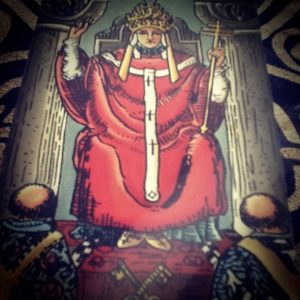 Authority | Tradition | Education | Discipline | Orthodoxy
Authority | Tradition | Education | Discipline | Orthodoxy
With card number 5, we move beyond the personal authority and nurturing of the Empress (Mother) and Emperor (Father) to the societal authority and nurturing involved with education and acculturation.
In the older decks, such as the Tarot de Marseilles, this card was named “The Pope.” In some other decks, it was styled “The High Priest.” Waite chose “Hierophant” (prelate of the Greek Eleusinian Mysteries).
As the High Priestess symbolizes a spiritual path based on intuition and turning within, the Hierophant represents the “outer path” of formal, dogmatic religious practices.
The two acolyte figures in the foreground of the card, bear the rose and lily motif mentioned earlier with the Magician card. Their practice is meant to reconcile spirit and flesh. We will see other “acolyte” cards as we move through the deck (triads such as the Lovers and the angel, the Charioteer and his sphinxes, the Devil and chained couple). They may represent subservience or acquiescence, or in the case of the 5 card, an initiation of some sort.
This card can represent (or recommend) a formal devotional practice, placing oneself under the tutelage of a master or expert, or enrolling in an educational activity. It may represent someone who has attained mastery, or is a teacher or other with an authoritative role in training or nurturing in a structured, systematic way. It can also represent conformity, or an adherence to tradition or formality of some sort.
For me, when the Hierophant has shown up in my single card daily draw, it’s been a prompt to revisit more structured paths of learning and spiritual practice, or to seek help from an authoritative source. The number five represents change, and this card acknowledges the role that tradition and formal practices can play in successfully navigating the transitions of our lives.
Leave a Reply